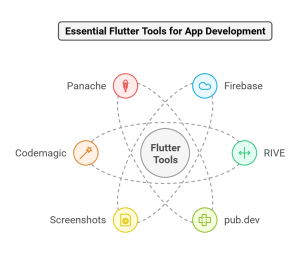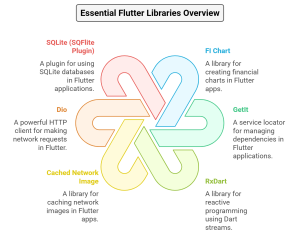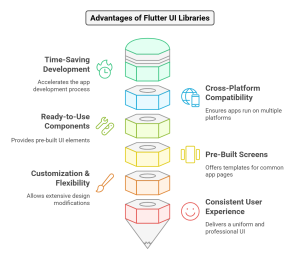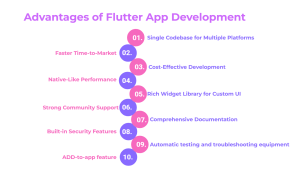Flutter, developed by Google, has rapidly become one of the most popular frameworks for building visually stunning, high-performance mobile and web applications. As an open-source UI toolkit, Flutter enables developers to create cross-platform applications with a single codebase, ensuring a smooth and consistent user experience across Android, iOS, and web platforms.
Flutter libraries and plugins efficiency, flexibility, and ease of use have made it a favorite among developers, cementing its position as a leading app development technology.
Understanding Libraries in App Development
Prior to venturing into flutter libraries and plugins, it’s essential to learn about the definition of libraries. In software development, a library refers to a set of pre-coded code modules that are intended to make and speed up development.
Reusable codebases offer ready-made functionalities so that developers can improve their apps without coding from scratch. Developers can improve performance, cut development time, and make their applications scalable by implementing the appropriate libraries.
Why Libraries Are Important in Flutter Development
Although Flutter itself is a robust framework, its real power is unleashed by taking advantage of its vast library ecosystem of packages, plugins, and best flutter packages. These libraries widen Flutter’s abilities and make it simpler to add features like animations, state management, network, and database integration.
Here in this article, we discuss some of the leading must-have Flutter component libraries to help boost your Android, iOS, and web application development workflow. We chose these libraries keeping in mind considerations like functionality, popularity, and regular updates, so you’re equipped with the best tools to make mobile application development efficient and scalable.
Whether you’re a beginner or an experienced developer, incorporating these Flutter libraries into your projects will help streamline your workflow and elevate your app’s performance.
Supercharge Your Flutter App Development
Enhance your Flutter projects with top-notch libraries and expert guidance. Our development team can help you integrate the best packages for animations, state management, networking, and more.
Hire ExpertLet’s explore the best Flutter libraries to take your app development to the next level.
Exploring the Best Flutter Libraries, Tools, Plugins, and Packages
Flutter’s ecosystem consists of various tools, plugins, libraries, and packages that enhance development efficiency. To simplify the selection process, we’ve categorized them based on their functions and use cases.
Top Flutter Tools for Mobile App Development

Following are the top flutter tools for mobile app development.
1. Firebase
Firebase is a comprehensive mobile backend solution that integrates seamlessly with Flutter tools. It offers essential services such as:
- Authentication (User sign-in & security)
- Crash Reporting (Bug tracking & error diagnostics)
- Analytics (User engagement & app performance insights)
By incorporating Firebase, developers can streamline backend functionalities without extensive coding efforts.
2. RIVE
RIVE, previously known as 2 Dimensions, is a powerful tool for designing UI animations and interactive components. It allows developers to create animations without relying on static mockups, making it ideal for creating visually engaging applications and games.
3. pub.dev
Pub.dev is a package management platform for Dart and Flutter developers. It provides access to thousands of open-source libraries, helping developers find and integrate the right tools into their projects with ease.
4. Screenshots
Screenshots is a command-line utility that enables developers to capture high-quality screenshots of their Flutter applications on both Android and iOS devices, making it a handy tool for app previews and documentation.
5. Codemagic
Codemagic enhances Flutter’s development workflow by automating the CI/CD (Continuous Integration/Continuous Deployment) process. It accelerates app testing, building, and deployment, making development more efficient.
6. Panache
Panache is a popular open-source Flutter tool for creating custom Material Design themes. It allows developers to design and apply unique themes by customizing colors, shapes, fonts, and other UI elements.
Widely used by Flutter agencies, Panache simplifies theme generation for stunning iOS and Android apps.
Also Read: Why Should You Choose Flutter
Most Popular Flutter Libraries for Mobile App Development

1. FI chart
FI chart is a popular Flutter library that allows developers to create visually appealing charts and graphs, such as:
- Line graphs
- Bar charts
- Pie charts
- Scatter plots
This library is widely used for data visualization in mobile applications, especially in analytics-driven projects.
2. GetIt
GetIt is a simple service locator for Dart and Flutter app creation. It helps developers manage dependencies efficiently, making it easier to structure and scale Flutter projects.
3. RxDart (Reactive Dart)
RxDart extends Dart’s native capabilities by implementing reactive programming patterns similar to Redux in ReactJS. It is commonly used for state management and stream handling in complex Flutter applications.
4. Cached_network_image
This library optimizes image loading by caching images locally. It reduces network requests and speeds up UI rendering, making it ideal for apps that rely heavily on images, such as social media and e-commerce applications.
5. Dio
Dio is a powerful HTTP client for Flutter, designed to handle network requests, API interactions, and data fetching. It supports features like:
- Interceptors
- Request cancellation
- File downloads
- Token-based authentication
6. SQLite (SQFlite Plugin)
Flutter does not include built-in support for SQLite databases, but the SQFlite plugin provides seamless database integration. Developers can use it for local data storage, enabling offline access and efficient data management.
7. Package_info
Package info is a useful Flutter library that allows developers to retrieve metadata such as:
- App version
- Package name
- Build number
This information helps in tracking updates and maintaining app consistency across versions.
8. Qr flutter
Qr flutter is a widely used Flutter library that enables developers to generate and display QR codes within their apps. It is commonly used for payment systems, ticketing, and authentication processes.
Top Flutter Packages for Efficient Development

1. Image_picker
Image_picker allows users to select images from their device’s gallery or capture photos using the camera. It supports multiple file formats, including JPG, PNG, and GIF.
2. Path_provider
Path_provider is a popular Flutter package that provides access to device storage and file system directories. It is useful for saving, retrieving, and managing application files efficiently.
3. SQLite (SQFlite Plugin)
The SQLite package helps developers integrate SQLite databases into their Flutter applications, making local data storage and management more effective.
4. Scope Model
Scope Model simplifies state management in Flutter applications by allowing different components to communicate without relying on global variables. This enhances modularity and scalability.
Boost Your Flutter App with Essential Packages
Streamline your Flutter development with top-tier packages for image handling, storage, database management, and state management. Our experts can help you integrate the best tools for a seamless app experience.
Hire ExpertBest Flutter Plugins for Mobile App Development

1. FlutterFire
FlutterFire is an official flutter plugin that allows developers to integrate Firebase services into Flutter applications. It supports features like:
- Authentication (Google Sign-in, Facebook Login, etc.)
- Cloud Firestore (Real-time database management)
- Push notifications
2. Flutter Gallery
Flutter Gallery is an image gallery flutter plugin that provides smooth transitions and slideshow functionality. It enables users to browse images with a seamless experience similar to Google Photos.
3. Flutter Material
Flutter Material ensures that applications adhere to Material Design principles, offering pre-built widgets and UI components flutter UI libraries to maintain a polished and modern look.
Why use a Flutter UI library?
Flutter UI libraries play a vital role in accelerating the mobile app development process by providing pre-built, reusable components. These libraries enable developers to save time and effort by offering a collection of ready-to-use UI elements, eliminating the need to create interfaces from scratch.
Key Benefits of Using a Flutter UI Library

1- Time-Saving Development Process
By leveraging pre-designed UI components, developers can significantly reduce the time spent on coding repetitive elements such as buttons, forms, and layouts. This speeds up the overall development cycle, allowing for quicker app deployment.
2- Cross-Platform Compatibility
A major advantage of Flutter UI libraries is their seamless integration with both Android and iOS platforms. Since Flutter operates on a single codebase, UI components are designed to maintain consistency and deliver a uniform user experience across different devices.
3- Ready-to-Use Components
Flutter UI libraries come equipped with a variety of essential UI elements, including:
- Buttons: Standard, floating, and customizable buttons for various actions.
- Cards: Elegant card-based designs for displaying grouped content.
- Forms: Input fields, checkboxes, radio buttons, and validation-ready forms.
- Layouts: Grid, column, and row structures to simplify page design.
4- Pre-Built Screens for Common App Pages
Many UI libraries offer pre-configured page templates that can be directly integrated into an application. These commonly used screens include:
- Login & Signup Pages: Ready-made authentication screens with form validation.
- OTP Verification: Secure one-time password input fields with auto-detection support.
- Onboarding Screens: Interactive introduction pages with swipeable guides.
- Profile Pages: User-friendly templates for managing personal information.
5- Customization & Flexibility
While these UI components are pre-built, they are highly customizable. Developers can modify their design elements, such as colors, fonts, shapes, and animations, to match the app’s branding and user experience requirements. This flexibility ensures that each application maintains a unique and visually appealing design.
6- Consistent & Professional User Experience
Using a UI library ensures that applications have a polished and professional look, regardless of their complexity. These libraries follow Material Design and Cupertino guidelines, ensuring smooth performance and a familiar experience for users on both platforms.
Pros and Cons of Flutter App Development:
Flutter has received sizable recognition as a pass-platform development framework, providing numerous blessings for corporations and developers. However, like any generation, it also has a few drawbacks. Understanding both the advantages and demanding situations of Flutter will help you decide if it’s the proper choice to your app development desires.
Advantages of Flutter App Development

Following are the professionals of flutter app development:
1. Single Codebase for Multiple Platforms
One of Flutter’s largest blessings is its capacity to apply an unmarried codebase to create packages for Android, iOS, web, or even computer systems. Developers need to jot down code as soon as and may install it across more than one working system, doing away with the need for separate improvement efforts for each platform.
2. Faster Time-to-Market
Since Flutter permits builders to put in writing one codebase for a couple of systems, the general improvement time is significantly reduced. Teams can be aware of building features in preference to writing and preserving a couple of code versions, leading to quicker app launches.
3. Cost-Effective Development
By reducing the need for separate development teams for exceptional systems, Flutter allows businesses to cut down on improvement fees. The capacity to reuse code across systems reduces costs associated with coding, trying out, and ongoing renovation.
4. Native-Like Performance
Flutter apps don’t rely upon intermediaries like JavaScript bridges, that can gradual down overall performance. Instead, Flutter makes use of Skia Graphics Engine, ensuring easy animations and high-performance applications that are like native apps on both Android and iOS.
5. Rich Widget Library for Custom UI
Flutter’s widget-based structure makes UI improvement flexible and customizable. It gives a wide variety of pre-built widgets for designing lovely consumer interfaces. Developers also can create custom widgets to fit particular branding requirements, supplying an unbroken user experience across platforms.
6. Strong Community Support
With Google backing Flutter, the framework has a swiftly developing network of builders. This means ample sources, such as boards, tutorials, and open-supply contributions, making it easier for builders to discover solutions and share expertise.
7. Comprehensive Documentation
Google offers properly-established, precise documentation for Flutter, making it easy for builders, whether novices or experienced professionals, to learn and put into effect the framework effectively.
8. Built-in Security Features
Flutter ensures protection at the syntax stage, with UI code jogging in unmarried-threaded execution and computational obligations being processed in remote sandboxes. This reduces the risk of vulnerabilities as a result of risky shared assets.
9. Automatic testing and troubleshooting equipment
The pulsation comes with a built tester tool kit that allows developers to write and run effectively, which improves application stability. Hot Relot function improves productivity by letting developers look at the real -time changes in their app.
10. ADD-to-app feature
For those businesses that already have native apps, the ad-to-app feature to Floater provides the opportunity for uninterrupted integration of flagging components into an existing project. This means that you can introduce new features by using a flute without rebuilding the entire app and protecting both time and resources.
Disadvantages of Flutter App Development

1. Large app size
One of the deficiencies of the flag is that the apps manufactured with frameworks are larger in file size than the native apps. This is due to the inclusion of the rendering engine and involvement of the libraries required in the app package. Although adaptation techniques can help reduce the size, it is an idea for projects where file size is important.
2. Dart adoption
The whistle depends on the arrow, a language that is powerful, less popular than JavaScript, Java or C#. As a result, finding experienced darts can sometimes be challenging. However, as the pulsation continues to receive traction, the demand for darts continuously increases.
3. IOS Compatibility Challenges
Since Flutter is developed by way of Google, Android apps generally tend to perform better and acquire greater immediate guidance. While Flutter apps run on iOS, sure iOS-unique features may require extra customization due to platform boundaries.
4. Limited Third-Party Library Support
Compared to older frameworks like React Native or native improvement structures, Flutter still has a smaller choice of 1/3-celebration libraries. While this is improving with time, developers may every now and then locate themselves writing custom code for capabilities that might in any other case be implemented using existing libraries in other frameworks.
Final Thoughts
Flutter’s developing ecosystem of libraries, tools, plugins, and packages makes it an extraordinary desire for cellular app improvement. Whether you’re trying to enhance UI/UX, optimize overall performance, or streamline workflows, leveraging these assets can considerably improve your development level.
Flutter gives a powerful solution for agencies looking to construct top notch, price-powerful, and move-platform cellular programs. Its single codebase, fast improvement cycle, and local-like performance make it a tremendous desire for many projects.
FAQs:


















